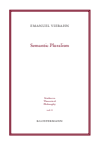Zusammenfassung
What is the content of a sentence in context? At most one proposition, says the standard view of propositionalism accepted in much of semantics. A set of propositions, says the hitherto little-explored view of semantic pluralism. The aim of this book is to motivate, develop and defend semantic pluralism. To achieve this aim, the book puts forward two arguments against semantic propositionalism. It spells out two versions of semantic pluralism: flexible pluralism, which takes many expressions to be context-sensitive, and strong pluralism, which denies that context-sensitivity is widespread. And it shows how pluralist theories can reply to several objections that have been lodged against non-propositional semantic theories.
Abstract
What is the content of a sentence in context? At most one proposition, says the standard view of propositionalism accepted in much of semantics. A set of propositions, says the hitherto little-explored view of semantic pluralism. The aim of this book is to motivate, develop and defend semantic pluralism. To achieve this aim, the book puts forward two arguments against semantic propositionalism. It spells out two versions of semantic pluralism: flexible pluralism, which takes many expressions to be context-sensitive, and strong pluralism, which denies that context-sensitivity is widespread. And it shows how pluralist theories can reply to several objections that have been lodged against non-propositional semantic theories.
Schlagworte
Flexible Pluralism Contextualism Semantic Pluralism Sentences Propositions Communication Semantics Strong Pluralism Language Analytical Philosophy- Kapitel Ausklappen | EinklappenSeiten
- 81–114 4. Semantic Pluralism 81–114
- 149–154 6. Outlook 149–154
- 155–162 Bibliography 155–162

